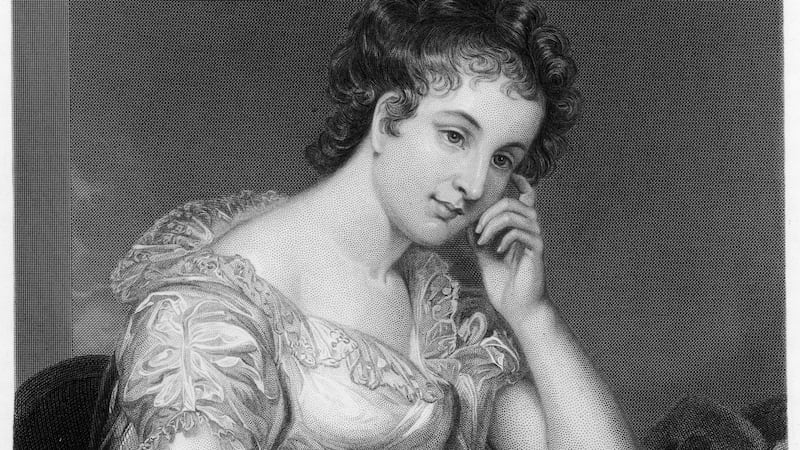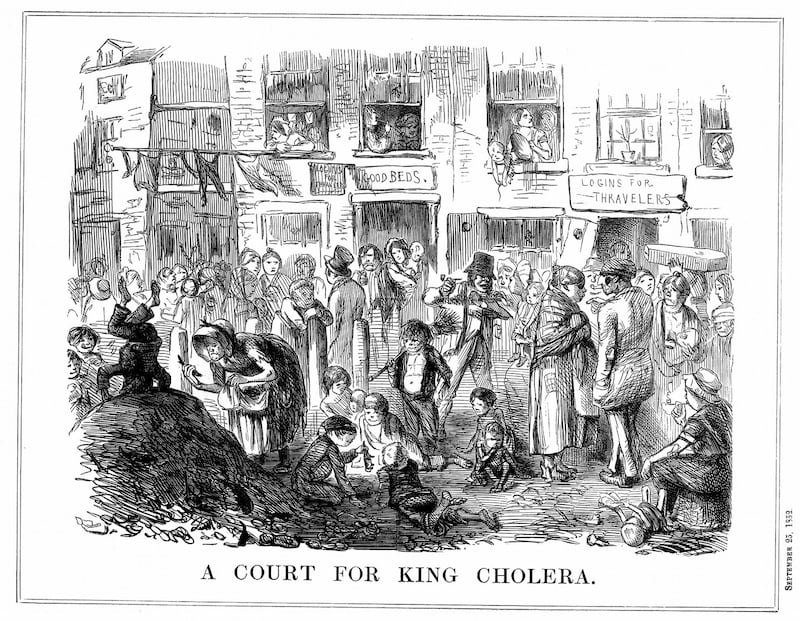Set at the close of the 21st century and published in 1826, Mary Shelley’s novel The Last Man paints a dire picture of a global pandemic, originating in Constantinople and causing the near extinction of mankind.
Readers have been returning to the novel, in part for its uncanny account of a virus that spreads between humans by airborne particles, its effects sharpened by social inequalities, but also for its message of care, responsibility and trust. As Eileen Hunt Botting put it in the New York Times: “The unexpectedly hopeful ending of The Last Man suggests that all disasters – however threatening to particular individuals or countries – are ultimately about humanity’s responsibility to the world as a whole.”
But the novel’s vision of “the world as a whole” is shaped by the outlook of a writer based in London. When Americans flee the global plague imagined in the novel, it is to England that they make their way, crossing first to Ireland and crowding into its seaports. There they feast on “superabundant” food and seize stray cattle but soon rouse “the fiery nature of the Irish”. Ragged bands of Irish and Americans head for England, some travelling as far north as Belfast in order to take the short sea crossing followed by the long road to London.

Populousness is an ever-present concern. The Americans come from a “populous continent”, while the Irish are represented mostly by their excess: “disorganised multitudes”, “unnatural numbers”, a “locust visitation”.
The population of Ireland was a wonder to early 19th-century commentators: when the census of 1821 was taken, the population of Ireland was measured at seven million, compared with 8.6 million in England and 1.6 million in Scotland. In 1820, there were more people living in the county of Mayo (c 300,000) than the city of New York (123,706).
In The Last Man, as the motley crew of Irish and Americans talk of “taking London, conquering England”, detailing “injuries which had for many years been forgotten”, the English make monsters of these outsiders and immigrants. The novel, though, rescues the hordes of Irish from their likely fate at the hands of the organised English troops. Kindness and decency prevail as both sides reckon with their shared vulnerability to the plague.
When the Irish are “quartered in deserted villages” or returned to their own island, it is hard not to hear an echo of Oliver Goldsmith’s The Deserted Village: “the country blooms – a garden and a grave”.
If Ireland exemplified a problem of population in the early years of the union, Britain in recent months has seemed a laboratory of Malthusian principles. The early UK government response to Covid-19 saw the pursuit of the objective of “herd immunity”, described by Irish man Dr Michael Ryan, executive director of the WHO health emergencies programme, as involving “a very brutal arithmetic that does not put people and life and suffering at the centre of that equation”.
The concept of “political arithmetick” was first used by William Petty in 1682, in relation to the post-Cromwellian plantation of Ireland. Counting is always political in Ireland, where the science of population gained a frightful influence in the years leading up to the Famine.

Maria Edgeworth, the most successful Irish novelist of her day, was also the writer most associated with the application of political economy to Ireland and its people. Admiring of Malthus’s principles and in agreement with many of his views on the poor, Edgeworth nonetheless confessed to shame in being disturbed by Malthus’s appearance and “snuffly” speech (he was born with a hare lip and a cleft palate). She met him in the early months of a long visit to England from October 1830 to July 1831 and described his “uncouth mouth” and “horrid voice” in letters home.
At the outset of that trip, freshly arrived from the Liverpool boat, Edgeworth expressed her pleasure in travelling through “rich clean looking England”. Yet she was soon reassuring relatives concerned about the Swing Riots in Kent. The science of population and political economy became increasing concerns as Edgeworth travelled through England.
About July 1831, she began to hear rumours of the spread of a dreadful disease named “cholera morbus”. The first confirmed case was reported in Sunderland in October, just as Edgeworth was making her way back to Ireland. Rumours of this strange disease had been spreading since its first outbreak in India in 1817. It was notable for severe, novel symptoms and high mortality rates: by 1832, some 52,000 people had died in England, Scotland and Wales.
Spread by contaminated water, cholera ravaged poor crowded communities. The disease reached Ireland by March 1832, killing almost 50,000 people. The relative numbers clearly indicated the depths of Irish poverty. A second outbreak of cholera in 1849 struck Famine-era Ireland with terrible force: it killed another 30,000, with mortality rates as high as 40 per cent in Cork and Dublin.

Stopping with family friends near Birmingham en route home to Longford, Edgeworth had discussed cholera in some detail with a surgeon named Samuel Hudson, “a plain spoken clear-thinking man”, interested in earlier responses to contagion. She recommended to Hudson that he read Alessandro Manzoni’s historical novel of 1827, I Promessi Sposi, “for the sake of the plague”. Hudson, in turn, lent Edgeworth a medical journal with a description of the horrifying effects of “cholera morbus”.
Along with I Promessi Sposi, set against the backdrop of an outbreak of bubonic plague in Milan in 1630, Hudson also read and admired RR Madden’s 1829 Travels in Turkey, Egypt, Nubia and Palestine. “There is in Madden,” Edgeworth reported, “the best description of the symptoms he ever read – except in [Daniel] Defoe – and what does it signify where the adjuncts of the story be true or not for our medical purposes if the symptoms and the medical history be exactly given”.
The conversation between the woman of letters and man of science ranged widely, from the uses of chlorine to the question of boils. It led Edgeworth to speculate on fiction more generally and she was pleased that this sensible surgeon saw the merits of reading literature in a time of contagion, noting in a letter home that: “If the feelings and the passions and their consequences be well described no matter for the rest.”
Edgeworth’s insistence on the utility of literature will not surprise readers familiar with her reputation for didacticism: she built a career writing novels intended to help English readers understand Ireland and her reputation declined as literary tastes changed and political contexts shifted irrevocably.
Arguably, a similarly utilitarian approach to literature dominates contemporary Ireland. In May, a HSE advertisement used lines from Take Care, a 1993 poem by President Michael D Higgins, “to motivate and inspire people to keep going with those actions that help us to stay safe and protect each other”. And on March 27th, as lockdown was announced, the RTÉ Nine O’Clock News closed with a recording of Derek Mahon reading Everything is Going to be Alright.
But is it? Even as lockdown restrictions ease across the globe, second surges are emerging, with predictions of waves to come. Who is to say what moments of comfort that are afforded by literature in these strange days? Shelley, though, makes it clear that poetry plays no part in the strange immunity that saves Lionel Verney, her last man. And Edgeworth is focused on “our medical purposes”.
Rather than expressing a generalised faith in a shared humanity, both writers place their trust in the numbers: singular men, distended populations and curious case histories. Such a focus seems strikingly in tune with the current mood, as we try to figure out the future by learning to read the data.
Claire Connolly is professor of modern English at University College Cork. She is co-general editor (with Marjorie Howes) of Irish Literature in Transition, 1700-2020, a new six-volume series from Cambridge University Press.












